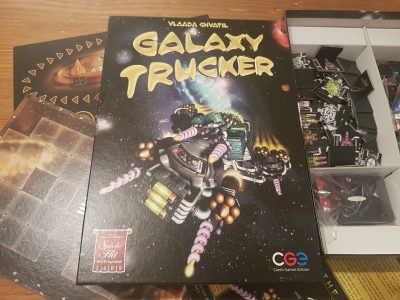Galaxy Tracker is humours tile placement and space exploration game, with limited dice rolling, from Czech Games. First released back in 2007, the game is for 2 – 4 players with an average game lasting around until the 60-minute mark. Players are tasked with the construction of junk from junk. Junk that can hurtle through space, carry sometimes radioactive cargo, remain habitable, counter pirates and survive everything space can throw at it. Chances are this “ship”, a term used in the loosest possible sense, won’t come back in one piece. Instead, players should go into the game expecting to lose at least a chunk of their ship to a meteor storm. If that’s not bad enough half the time there are opportunities for the crew to jump ship to an otherwise abandoned ship. To make matters worse, that’s only if they haven’t already been killed by pirates shooting at your ship.
A game of Galaxy Truckers is made up of three separate rounds, made of two phases: ship construction and flying. Each round is to some extent the same. Still, each time a different ship design is utilized, a higher count of adventure cards makes up the adventure deck and the stuff being thrown at players ramps up in difficulty. To start each round, players are given an empty ship schematic and their starting pilot cabin. In the middle of the table is a plethora of potential ship pieces from cannons to shields. However, all the pieces start face down adding to the mystery. Once “Go!” has been shouted by the boldest player the free-for-all building stage commences.
Players are only permitted to grab a single tile at a time. To make it that bit harder players must bring it back to their player board before they can turn it over to discover what it is. If it can fit onto your ship via the connector types, and you want it, just add it onto your board. If you don’t want it place it back in the middle, face up, and grab another piece. Once a piece is locked on a player board it cannot be removed. This grabbing for pieces continues until all ships are built or in advanced games when the sand timer runs out.
At their disposal players will be randomly picking up cannons, engines, shields, batteries, cargo holds, cabins and structural modules. Cannons and engines both come in two forms either singular or doubles, the latter requiring energy to use. For instance, a double engine provides two thrust if a player spends one energy token. Cannons cannot have another ship piece directly in front of it, you wouldn’t what to shoot your own ship now would you? In a similar way, engines cannot have a ship piece directly behind them and must point towards the backwards.
While guns will help protect against big meteors hurtling your way, shields are the only thing that’ll help against incoming laser fire. Players will need both energy to power the shield and one pointing in the right direction otherwise part of their ship will be shot off. Even if you have a shield, the laser fire can’t be too big. For these your only hope is a good dice roll! Batteries come with either space for 2 or 3 energy tokens. Each time a player needs to activate a shield, fire a double cannon or use a double engine they’ll need to spend an energy token, otherwise they don’t work. Naturally, cargo holds allow players to store any cargo they find on their journey, with red cubes having to be stored in special holds for radioactive material. Structural modules are the last standard ship part which are tiles used solely to help connect the junk together in a more secure design.
It wouldn’t be a true space themed game without aliens. Alongside the almost cute tiny space suited humans, two blob like aliens can join in on the action. Both the purple and brown aliens give bonuses but players must accommodate for them with special life support components. Each craft can only half one of each. Though they won’t win you the game on their own, these helpful blobs can turn the tide against pirates or smugglers, making aliens especially helpful in the third round. For having a purple alien on board, as long as you have a minimum of one cannon, it grants +2 to your cannons. The Brown alien, if you have an engine, gives +2 to engines. Rather helpful to let players just scrap by encounters or pull slightly ahead in open space.
Ships are built and now the journey unfolds. Eight random adventure cards are taken from the box. Depending on the round, four from each previous round are shuffled in. The adventure cards are where players can come across open space, planets, meteoric swarms and much more. In early rounds players will come across simpler adventures. For example, smugglers that turn up will only require players to have 4 cannons to defeat. Conversely, in the last round a pirate may take 8 cannons to defeat. Rewards will also ramp up in round 2 and 3, with the amount of credits earnt or resource cubes gained increasing. Adventure cards can also come with a penalty of days spent. This can see players dropping back in the running and a different player become the leader.
If your ship survives the barrage of space bonuses are earnt for positioning and goods obtained from planets can be sold. Unfortunately, when players arrive they must sell their ship back to Corporation Incorporated. For subsequent rounds players must build a new ship on top of a new ship design. Rebuilding ships is always fun, as it is a great part of the game. Alas, sometimes it is a tad unsatisfying when not much has occurred to a previous round’s ship.




